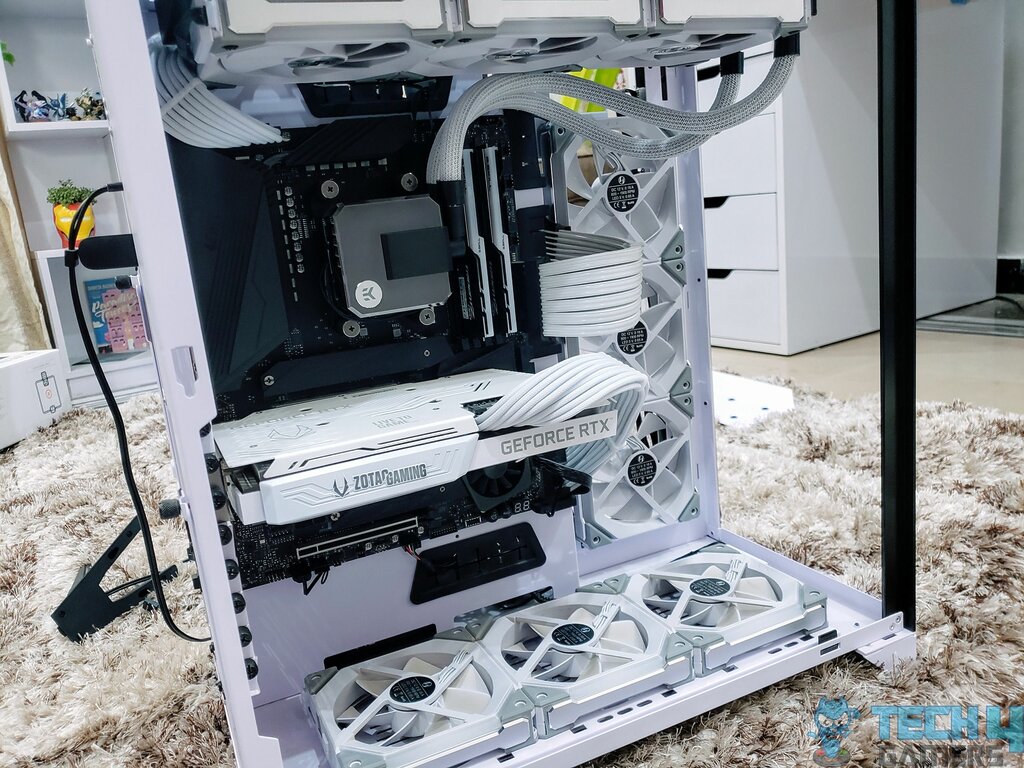- Full-tower cases provide extra space that is unneeded for most gamers. The chassis is also not viable for people who don’t have luxurious desks.
- E-ATX cases are bigger and significantly more expensive than many ATX cases.
- Thanks to the greater space, it’s easier to assemble PCs in full-tower cases than in mid-tower cases, which can get mashed up.
- E-ATX cases can be overbearing for many desks, while ATX cases provide a subtle and minimalistic look.
Over time, I have noticed a shift in the PC building community towards mid-tower PC cases. As someone who has used full-tower and mid-tower cases in many builds, I understand the pros and cons of both options. However, the trend is changing, and my latest build surprised me when I gravitated entirely to a mid-tower chassis. So, here’s why full-tower cases aren’t as popular as mid-tower cases.
Size And Space Considerations
When thinking about full-tower (E-ATX) cases, the first thing that comes to mind is their size. These cases are undeniably larger than the ordinary chassis; unlike in the past, we don’t need 18 hard drive bays. Sure, on the one hand, the extra space is great for high-end gaming rigs and custom water loops. However, for most of us, the additional size is impractical.
To explain, people like myself don’t have the leisure of a spacious gaming room or a big desk where we can comfortably fit an E-ATX chassis. This is where mid-tower cases come in handy. Mid-tower PC cases provide a perfect balance of enough space within the chassis while being more compact and manageable.
JayzTwoCents explains which case size is perfect for different use cases, showcasing the potential of mid-tower cases.
Bigger Cases Are More Expensive
Another major reason full-tower cases aren’t as popular as mid-tower cases is the cost implications of the former. The higher cost is usually relative to the materials and features E-ATX cases offer. However, average users don’t always require features such as additional connectivity or hot-swappable drive bays.
Take the Corsair 1000D Obisidian, for example. It towers at a luxurious ~$525 while offering a titanium body, built-in smart lighting, and a triple chamber design.
On the other hand, mid-tower cases are relatively affordable. They provide all the essential features to build a powerful gaming rig without the extra eye candy that triples the price. The Cooler Master MasterCase H500 A-RGB, costing around ~$139, provides everything a gamer like myself could ask for. So, for many, especially those on a budget, a mid-tower case is the perfect option to house their components without going out of budget.
E-ATX Cases Are Easier To Assemble In

When building and maintaining a PC, I always consider the chassis’ ease of assembly. Because full-tower cases are spacious, they are much easier to build in rather than mid-tower cases. The greater space is the main reason why I have preferred E-ATX cases for a long time.
Full-tower cases are prone to look empty if you’re not planning a custom water loop. That’s why a mid-tower chassis is perfect for most gaming rigs. You might have trouble with the cable management and be required to stuff in the components, but there won’t be any issues with airflow or PC temperatures.
Aesthetics And Trends
Although not the most important factor when choosing a PC case, I consider the aesthetics the chassis provides. I don’t only look at the PC’s appearance in the chassis but also whether the chassis complements the room’s overall aesthetic. Due to their larger size, full-tower PC cases tend to dominate the desk space.
On the other hand, mid-tower cases offer more subtle and versatile aesthetics that blend within most desk designs. Whether you’re looking for a minimalistic design or want to build an exotic PC, an ATX case can provide the aesthetics you want.
The Perfect Fit For Most Users
In conclusion, finding the perfect PC case for your use case scenario can be tricky. However, you should keep in mind that full-tower cases aren’t as popular as mid-tower cases, and if possible, you should stick with the latter to save costs and space.
Whether upgrading or building your first PC, a mid-tower case can likely meet all your needs and requirements without a full-tower chassis. Even so, with the advancement of hardware, I can’t wait to see how more compact PCs can become without compromising airflow and temperatures.
Thank you! Please share your positive feedback. 🔋
How could we improve this post? Please Help us. 😔
[Hardware Reviewer]
Awais Khan is a Tech Geek, conscientious, reliable, and hardworking individual who pays attention to detail with excellent time management skills. Alongside that, he is an expert in PC Hardware; dealing with Benchmarks, Analysis, and testing before sharing information with readers. Whenever free, Awais occasionally shares Gaming Videos on his YouTube Channel.
Get In Touch: awais@tech4gamers.com


 Threads
Threads

